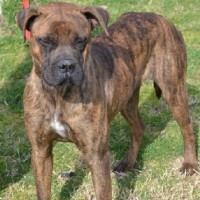Appearance of the Boxmas
|
| Standing tall, this massive breed may intimidate those unfamiliar with the gentle giant. Their tall body is muscular and strong. Boxmas' legs are long with its large paws. The ears are of medium length and resemble Mastiff features. The tail can be left natural or docked. The coat is short, dense and water-repellent, varying from white to brown to black. When fully grown, these massive dogs weigh between 32 and 45 kilos. The appearance of Boxmas can vary according to their dominant features. As a general rule, this large breed will strongly resemble the Mastiff. |
Temperament of the Boxmas
|
| Like other hybrid breeds, the Boxmas' temperament can vary according to the dominant traits it inherits. They may inherit the energetic nature of the Boxer, or develop a more docile disposition. This friendly dog is known for being cheerful, genuine, friendly, loyal, protective and affectionate. Its personality makes it a suitable pet. Early training should be provided so that your Boxmas fully accepts young children. Make sure your dog doesn't become too attached to just one member of the family. Early socialization and interaction with all family members will prevent this from becoming a problem. Your dog may need to learn to distinguish between a friendly stranger and a hostile intruder. Once he understands the difference, he can be affectionate and loving towards others. Providing positive reinforcement is key with Boxmas. It's important to be firm with commands and reward with treats. The Boxmas is considered a highly intelligent breed that wants to accompany its family everywhere. Their energy levels are generally described as high. |
Needs and activities of the Boxmas
|
| Boxmas require high instances of stimulation to stay engaged and avoid boredom. This breed is very exuberant and will need intense outdoor play. This active dog is used to being used as a guard dog, protection dog and military/police dog. Staying active ensures that this breed gets the mental work it needs to be satisfied. Boxmas will benefit from activities such as running, tugging, retrieving, obedience classes and plenty of walks totaling at least an hour out every day. With a breed as large as the Boxmas, apartment living should be avoided. Because exercise is a top priority for this breed, a large rural home with a spacious yard would be the best solution. A warm climate is ideal. |
Maintenance of the Boxmas
|
| The Boxmas is not a hypoallergenic breed and has high levels of excretion. If you have allergies, this breed may not be the best solution for you. Daily brushing is necessary to remove dead hairs and prevent hair from accumulating around your home. The best brush to use would be a rubber curry brush, although a detangler can sometimes come in handy. This active canine breed contains a moderate odor that can be mitigated with baths every 6 to 8 weeks. Excessive bathing can lead to overproduction of oils in the skin. Ears should be wiped and cleaned at least once a week. Teeth should be brushed, ideally every day, to remove tartar. Nails should be trimmed every 2-3 weeks to prevent overgrowth and discomfort. |









 English (United Kingdom)
English (United Kingdom)